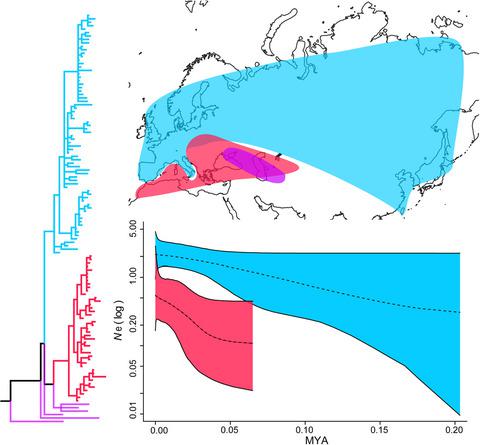当前位置:
X-MOL 学术
›
J. Zool. Syst. Evol. Res.
›
论文详情
Our official English website, www.x-mol.net, welcomes your
feedback! (Note: you will need to create a separate account there.)
Phylogeography and population history of the least weasel (Mustela nivalis) in the Palearctic based on multilocus analysis
Journal of Zoological Systematics and Evolutionary Research ( IF 2.0 ) Pub Date : 2019-11-26 , DOI: 10.1111/jzs.12330 Takuma Sato 1 , Alexei V. Abramov 2 , Evgeniy G. Raichev 3 , Pavel A. Kosintsev 4, 5 , Risto Väinölä 6 , Takahiro Murakami 7 , Yayoi Kaneko 8 , Ryuichi Masuda 1, 9
Journal of Zoological Systematics and Evolutionary Research ( IF 2.0 ) Pub Date : 2019-11-26 , DOI: 10.1111/jzs.12330 Takuma Sato 1 , Alexei V. Abramov 2 , Evgeniy G. Raichev 3 , Pavel A. Kosintsev 4, 5 , Risto Väinölä 6 , Takahiro Murakami 7 , Yayoi Kaneko 8 , Ryuichi Masuda 1, 9
Affiliation

|
The least weasel (Mustela nivalis) is one of the most widely distributed carnivorans. While previous studies have identified distinct western and eastern mitochondrial DNA (mtDNA) lineages of the species in the western Palearctic, their broader distributions across the Palearctic have remained unknown. To address the broad‐scale phylogeographical structure, we expanded the sampling to populations in Eastern Europe, the Urals, the Russian Far East, and Japan, and analyzed the mtDNA control region and cytochrome b, the final intron of the zinc finger protein on Y chromosome (ZFY), and the autosomal agouti signaling protein gene (ASIP). The mtDNA data analysis exposed the previous western lineage (Clade I) but poorly supported assemblage extending across Palearctic, whereas the previous eastern lineage (Clade II) was reconfirmed and limited in the south western part of the Palearctic. The ZFY phylogeny showed a distinctive split that corresponding to the mtDNA lineage split, although less phylogeographical structure was seen in the ASIP variation. Our data concur with the previous inference of the Black Sea–Caspian Sea area having an ancestral character. The Urals region harbored high mitochondrial diversity, with an estimated coalescent time of around 100,000 years, suggesting this could have been a cryptic refugium. Based on the coalescent‐based demographic reconstructions, the expansion of Clade I across the Palearctic was remarkably rapid, while Clade II was relatively stable for a longer time. It seems that Clade II has maintained a constant population size in the temperate region, and the expansive Clade I represents adaptation to the cold regions.
中文翻译:

基于多基因座分析的古北最少黄鼠狼(Mustela nivalis)的系统志和种群历史
最少的鼬鼠(Mustela nivalis)是分布最广泛的食肉动物之一。尽管先前的研究已经确定了西古太平洋中该物种的独特的线粒体西部和东部线粒体DNA(mtDNA)谱系,但它们在整个古太平洋的更广泛的分布仍然未知。为了解决大规模的植物地理结构,我们将采样范围扩大到东欧,乌拉尔,俄罗斯远东和日本的人群,并分析了mtDNA控制区和细胞色素b(Y上锌指蛋白的最终内含子)染色体(ZFY)和常染色体刺骨信号蛋白基因(ASIP))。mtDNA数据分析暴露了先前的西部血统(I进化枝),但在整个古北纪延伸的组合却缺乏支持,而先前的东部血统(Clade II)在古西南的西南地区又得到了确认和限制。所述ZFY系统发生表明,对应于所述的mtDNA谱系分裂鲜明的分裂,虽然少系统地理结构在看到ASIP变异。我们的数据与黑海-里海地区具有祖先特征的先前推论一致。乌拉尔地区的线粒体多样性很高,估计合并时间约为100,000年,这表明这可能是一个隐蔽的避难所。根据基于联盟的人口统计重建,克莱德一世在整个古埃及的扩张非常迅速,而克莱德二世在较长时间内相对稳定。进化枝II似乎在温带地区保持了恒定的种群规模,而膨胀的进化枝I则表明它适应寒冷地区。
更新日期:2019-11-26
中文翻译:

基于多基因座分析的古北最少黄鼠狼(Mustela nivalis)的系统志和种群历史
最少的鼬鼠(Mustela nivalis)是分布最广泛的食肉动物之一。尽管先前的研究已经确定了西古太平洋中该物种的独特的线粒体西部和东部线粒体DNA(mtDNA)谱系,但它们在整个古太平洋的更广泛的分布仍然未知。为了解决大规模的植物地理结构,我们将采样范围扩大到东欧,乌拉尔,俄罗斯远东和日本的人群,并分析了mtDNA控制区和细胞色素b(Y上锌指蛋白的最终内含子)染色体(ZFY)和常染色体刺骨信号蛋白基因(ASIP))。mtDNA数据分析暴露了先前的西部血统(I进化枝),但在整个古北纪延伸的组合却缺乏支持,而先前的东部血统(Clade II)在古西南的西南地区又得到了确认和限制。所述ZFY系统发生表明,对应于所述的mtDNA谱系分裂鲜明的分裂,虽然少系统地理结构在看到ASIP变异。我们的数据与黑海-里海地区具有祖先特征的先前推论一致。乌拉尔地区的线粒体多样性很高,估计合并时间约为100,000年,这表明这可能是一个隐蔽的避难所。根据基于联盟的人口统计重建,克莱德一世在整个古埃及的扩张非常迅速,而克莱德二世在较长时间内相对稳定。进化枝II似乎在温带地区保持了恒定的种群规模,而膨胀的进化枝I则表明它适应寒冷地区。











































 京公网安备 11010802027423号
京公网安备 11010802027423号